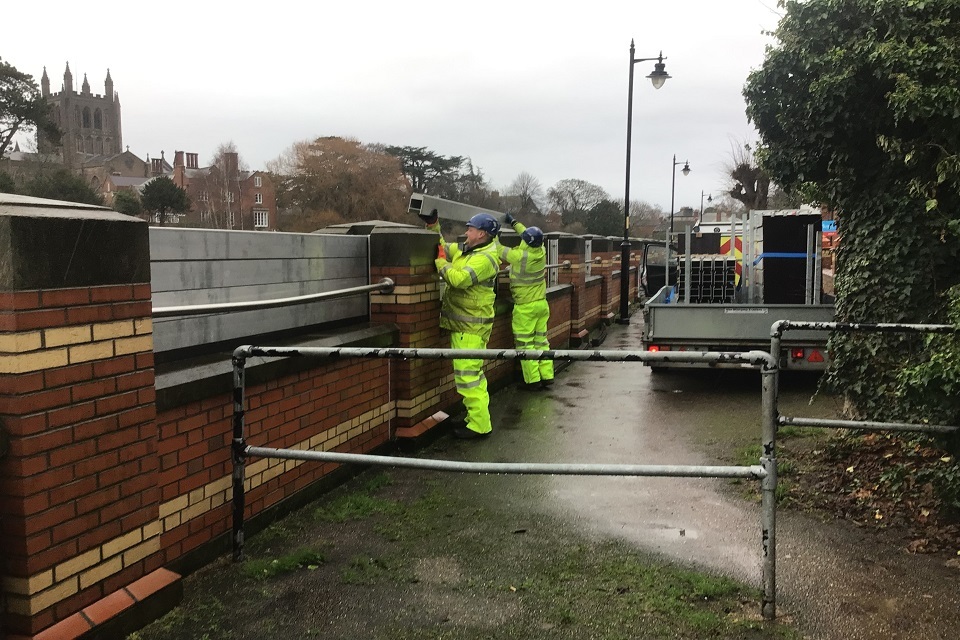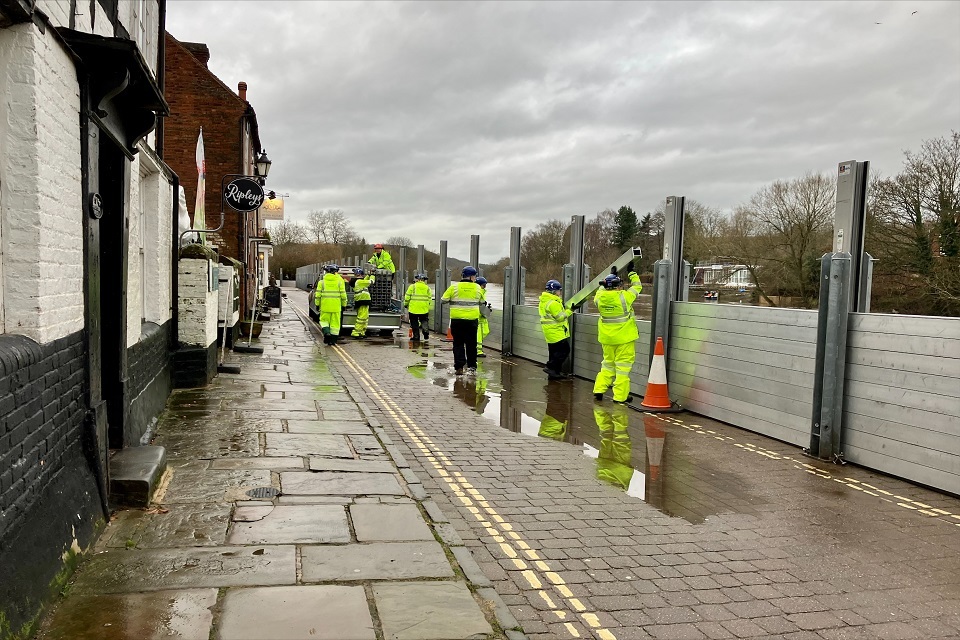Environment Agency prevents flood devastation across West Midlands
100 flood-risk staff worked night and day using barriers and pumps to protect 4,100 homes and businesses in Severn and Wye catchments from January flood.

A group of men in yellow jackets can be seen on scaffolding erecting a flood barrier at Frankwell in Shrewsbury
Early action by the Environment Agency protected more than 4,000 homes and businesses in the West Midlands from the devastation of flooding this January.
Environment Agency officers worked around the clock to deploy demountable barriers along the River Severn and River Wye, protecting communities after many persistent bands of rain earlier in the month resulted in elevated river levels.
Barriers were used to hold back floodwater across the region, including Shrewsbury, Ironbridge, Bewdley and Hereford, whilst a large flood pumping station operated continuously for two weeks in Kempsey, as well as flood gates being closed at Upton-upon-Severn. Other flood risk assets operated in Cheltenham, Worcester and Gloucester to prevent flooding.

Thousands of West Midlands homes and businesses like here at Hereford were protected from flooding earlier this month thanks to the Environment Agency
The Environment Agency also issued a total of 39 flood alerts and 61 flood warnings from the beginning of the year.
While some properties sadly did flood, many more were protected thanks to the measures taken. Being flooded is devastating, and the Environment Agency will work with partners over the coming weeks to support the recovery of those communities affected over recent weeks.
Environment Agency operations manager Anthony Perry said:
We saw a lot of heavy rainfall at the beginning of the year that meant the Severn and Wye catchments became very saturated, and river levels rose quickly.
We operated our flood defences, which stood up to the challenge, and provided valuable protection to more than 4,000 homes and businesses in the area.
Without the public investment of these defences, many communities could have been flooded and faced weeks before being able to return to their homes. Instead, residents faced minimal disruption, and businesses were able to carry on their operations.
More than 100 Environment Agency staff put up barriers, ensuring watercourses were clear of debris, and operated pumps to remove surface water.

Bewdley sits on the banks of the River Severn. These flood barriers protected the Worcestershire town from New Year flooding
You can check your flood-risk, sign up for free flood warnings, and keep up-to-date with the latest situation at https://www.gov.uk/check-flood-risk, call Floodline on 0345 988 1188 or follow @EnvAgency on Twitter for the latest flood updates.
- In the 2020 Budget, the Government doubled its investment in flood and coastal erosion risk management in England by committing a record £5.2bn over the next six years. This long-term commitment will better-protect hundreds of thousands of properties, including homes, businesses, schools and hospitals.
- For every £1 spent improving protection from flooding and coastal erosion, we avoid around £5 of property damages. This long-term commitment will make homes, businesses and infrastructure more resilient to the increasing impacts of climate change.
- This record investment will help the nation ‘build back better’ by making properties more resilient to flooding, and ‘build back greener’ by working with nature to make us more resilient to climate change.
- The Capital Programme will also prove central to the Environment Agency reaching its target of becoming a net zero organisation by 2030 – by embracing innovative ways of working that minimise the carbon emissions we produce, and the carbon produced through our supply chain, when we build flood defences.
- The investment across the country will help enable communities adapt to the future risk of climate crisis.
- Using partnership funding enables us to secure investment beyond levels affordable to central government alone and enables more local choice, while encouraging innovative, cost-effective options where communities may play a greater role.